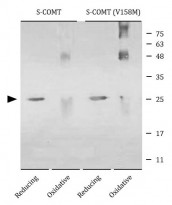ARG24043
anti-S-COMT antibody [BCAB1374]
anti-S-COMT antibody [BCAB1374] for Indirect ELISA,Western blot and Human
Overview
| Product Description | Mouse Monoclonal antibody [BCAB1374] recognizes S-COMT |
|---|---|
| Tested Reactivity | Hu |
| Tested Application | I-ELISA, WB |
| Specificity | The antibody reacts with the Human S-COMT (wild type) and S-COMT (V158M). |
| Host | Mouse |
| Clonality | Monoclonal |
| Clone | BCAB1374 |
| Isotype | IgG |
| Target Name | S-COMT |
| Antigen Species | Human |
| Immunogen | Recombinant Human S-COMT. |
| Conjugation | Un-conjugated |
| Alternate Names | EC 2.1.1.6; Catechol O-methyltransferase; HEL-S-98n |
Application Instructions
| Application Suggestion |
|
||||||
|---|---|---|---|---|---|---|---|
| Application Note | WB: Under reducing conditions. * The dilutions indicate recommended starting dilutions and the optimal dilutions or concentrations should be determined by the scientist. |
||||||
| Observed Size | ~ 25 kDa |
Properties
| Form | Liquid |
|---|---|
| Purification | Purification with Protein A. |
| Buffer | PBS (pH 7.5), 20 mM Sodium phosphate, 150 mM NaCl and 0.05% Sodium azide. |
| Preservative | 0.05% Sodium azide |
| Storage Instruction | For continuous use, store undiluted antibody at 2-8°C for up to a week. For long-term storage, aliquot and store at -20°C or below. Storage in frost free freezers is not recommended. Avoid repeated freeze/thaw cycles. Suggest spin the vial prior to opening. The antibody solution should be gently mixed before use. |
| Note | For laboratory research only, not for drug, diagnostic or other use. |
Bioinformation
| Database Links | |
|---|---|
| Gene Symbol | COMT |
| Gene Full Name | catechol-O-methyltransferase |
| Background | Catechol-O-methyltransferase catalyzes the transfer of a methyl group from S-adenosylmethionine to catecholamines, including the neurotransmitters dopamine, epinephrine, and norepinephrine. This O-methylation results in one of the major degradative pathways of the catecholamine transmitters. In addition to its role in the metabolism of endogenous substances, COMT is important in the metabolism of catechol drugs used in the treatment of hypertension, asthma, and Parkinson disease. COMT is found in two forms in tissues, a soluble form (S-COMT) and a membrane-bound form (MB-COMT). The differences between S-COMT and MB-COMT reside within the N-termini. Several transcript variants are formed through the use of alternative translation initiation sites and promoters. [provided by RefSeq, Sep 2008] |
| Function | Catalyzes the O-methylation, and thereby the inactivation, of catecholamine neurotransmitters and catechol hormones. Also shortens the biological half-lives of certain neuroactive drugs, like L-DOPA, alpha-methyl DOPA and isoproterenol. [UniProt] |
| Cellular Localization | Isoform Soluble: Cytoplasm. Isoform Membrane-bound: Cell membrane; Single-pass type II membrane protein; Extracellular side. [UniProt] |
| Calculated MW | 30 kDa |
| PTM | The N-terminus is blocked. [UniProt] |
Images (1) Click the Picture to Zoom In
-
ARG24043 anti-S-COMT antibody [BCAB1374] WB image
Western blot: 100 ng of S-COMT (lane 1 & 2) and 100 ng of S-COMT (V158M) (lane 3 & 4). The blots were stained with ARG24043 anti-S-COMT antibody [BCAB1374], under reducing conditions, with DTT, 10 min at 95°C (lane 1 & 3) or oxidative conditions (lane 2 & 4).






